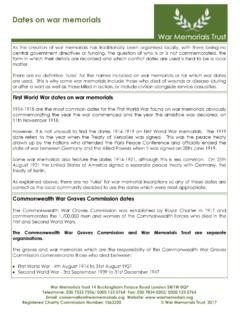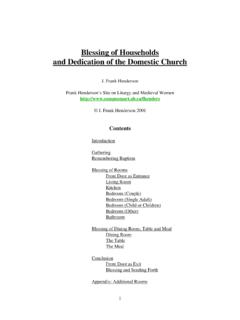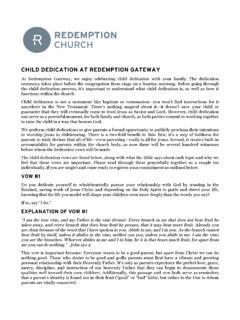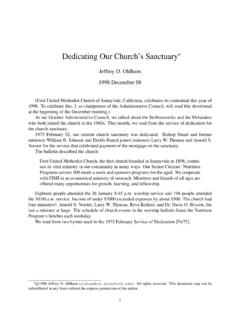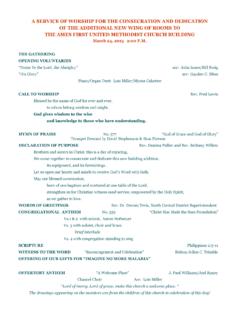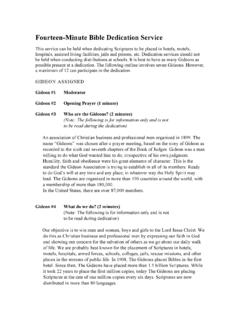Transcription of Dedication and rededication ceremonies - War Memorials Trust
1 Look Visit the war memorial and have a look at it s condition. Take photographs and copy down any inscriptions/names to ensure you have an accurate record of its current state. This is important - if damage were to occur to the war memorial you should know how it looked before the damage occurred. This information can also form the basis of a maintenance plan which will be discussed later. Investigate All war Memorials have a history and uncovering that is important for managing the memorial. Details of how it was put up and by whom can answer ownership issues, information on how the names that appear on it were identified can help you assess any future requests for names to be added and details of the materials can help with maintenance. This element can be time consuming but that is no reason to ignore it.
2 There are a number of organisations that can help, and indeed many people who would be fascinated to uncover the history. Please see War Memorials Trust s Researching the history of a war memorial and Researching the names on a war memorial helpsheets for further information. The War Memorial Register (c/o Imperial War Museum, Lambeth Road, London SE1 6HZ, T: 020 7207 9851, E: W: ) is aiming to compile a comprehensive record of all war Memorials in the UK. They may already have information on your memorial which you can obtain, alternatively if they do not you can supply it when this stage has been completed. Local history societies, civic trusts, local community groups, schools, students and local people are all possible sources of help. There is sure to be someone who has the time and interest to undertake the project.
3 Remember this only needs to be done once. Making the effort now will ensure all the information is held together and can be consulted in the future. The law There is actually very little legislation covering war Memorials but it is worth ensuring you know what is out there. - The War Memorials (Local Authorities Powers) Act of 1923 and subsequent amendments, is Custodianship of war Memorials varies as they were generally erected through public subscription by communities and the issue of 'ownership' was inappropriate. However for whoever is now responsible, whether it has been over the long-term or recently acquired, it need not be a difficult task. This helpsheet is designed to help you with some simple guidance. Looking after your war memorial War Memorials Trust 14 Buckingham Palace Road London SW1W 0QP Telephone: 020 7233 7356/ 0300 123 0764 Fax: 020 7834 0202/ 0300 123 0765 Email: Website: Registered Charity Commission Number: 1062255 War Memorials Trust , 2017 the main piece of legislation.
4 In essence it enables local councils to take on responsibility for a war memorial, or to add names to it, without obliging them to. Please see War Memorials Trust s Parliamentary acts related to war Memorials helpsheet for further information. - Some war Memorials are listed and will be affected by listed building consent. You can check with the local council if your war memorial is listed and should keep a record of this and ensure you understand the implications. If it is not listed (and is eligible to be) you may wish to consider making an application. Please see War Memorials Trust s Listing war Memorials helpsheet for further information. - Depending on where the war memorial is, and its history, other issues may be relevant such as planning, church faculties, etc.
5 These will have to be identified by you; the historical research will help with this. Assess Having looked at the war memorial you will need to assess whether there are any issues that need to be dealt with. Is the memorial in good condition? - If so, then a maintenance plan (see below for details) can be established to maintain this. If not, then action will need to be taken to rectify the problems. Work may need to be undertaken by specialist conservator and advice sought from War Memorials Trust . Is the memorial safe? - It is important to think about whether the war memorial is secure. Theft of metals is increasingly common and vandalism or graffiti always possible. Please see War Memorials Trust s guidance notes on the theft of war Memorials for further information and the Trust s grant schemes can support security measures if it is felt action needs to be taken.
6 You should also: - make certain you hold information on the memorial in case anything does happen particularly photographic evidence which helps to avoid disputes; - speak to the local Crime Prevention Officer to obtain practical advice and ensure the local police are aware of the war memorial; - discuss safety with the local council's Conservation Officer. They may have a record of important heritage/historical items and your war memorial could be added; - ensure that the details of your war memorial are held by the UK National Inventory of War Memorials so that there is a secure second source of information; - consider insurance for the memorial, please see War Memorials Trust s Insurance for war Memorials helpsheet for further information. Maintain A regular maintenance programme is vital to ensure the war memorial is preserved.
7 Identifying any problems early will enable you to take action quickly and early preventative work can be less intrusive, less damaging and cheaper than a larger restoration project at a later date. The maintenance plan should be overseen by the custodian but could involve local volunteers or groups. Please see War Memorials Trust s Advice on the maintenance of war Memorials guidance notes for further information. A maintenance plan can be very simple - an annual visit to the war memorial, completing War Memorials Trust s Condition survey for your own records and taking photographs, is likely to be sufficient for most war Memorials to identify problems. Close attention should be paid to relevant parts of the war memorial, whether the names and inscriptions can be read, if the war memorial s pointing is in good condition (damaged pointing can lead to water retention which causes damage), etc.
8 Conserve However well cared for a war memorial is from time to time work will be required to preserve it. Custodians should ensure that those used to carry out work are suitably qualified and the work is in line with the best current conservation practice to avoid any damage to the war memorial. Please see War Memorials Trust s Conservation contacts helpsheet for further information. War Memorials Trust is able to provide advice and guidance if a problem is identified but a solution is unclear. Advice can be given on the work required and potential financial assistance if photographs and information are provided. Community involvement Think about how you can involve the community as if they are aware of the war memorial then they can help monitor it and alert you to any problems.
9 For example: - the investigative element could be extended to look into those recorded on the war memorial. The stories of those commemorated help us to understand their sacrifice and displays and information sessions can be community events. Please see War Memorials Trust s Researching names on a war memorial helpsheet for further information; - the local school might wish to incorporate a visit to the war memorial as part of their studies; - once material about the war memorial has been gathered, depending on the type of war memorial, perhaps an information board could be erected nearby. By educating people they will take a greater interest and a display board could also provide warning messages to assist with security if this is a problem; - ensure the community are involved in any changes or issues related to the war memorial.
10 For example if you are going to add a name let the local community know well in advance of any work (it is surprising how often it was not just one name that was missed off) or if you are going to clean the war memorial don't keep that information to yourself - seeing workmen doing something to a war memorial can worry people and lead to a lot of enquiries. Please note that this helpsheet is intended to offer informal advice and is a distillation of experience. The information contained in this helpsheet is not exhaustive and other sources of information are available.



